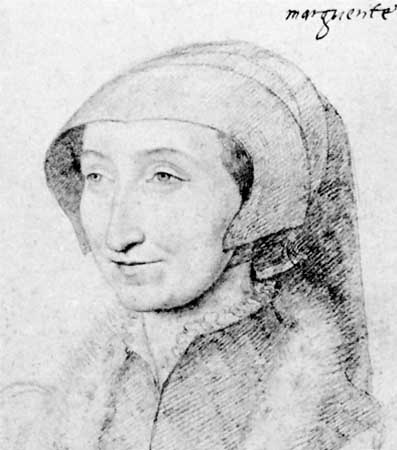Margaret Of Angoulême
French queen consort and poet
also called Margaret Of Navarre, French Marguerite D'angoulême, or De Navarre, Spanish Margarita De Angulema, or De Navarra
born April 11, 1492, Angoulême, Fr.
died Dec. 21, 1549, Odos-Bigorre
 queen consort of Henry II of Navarre, who, as patron of Humanists and Reformers, and as an author in her own right, was one of the most outstanding figures of the French Renaissance.
queen consort of Henry II of Navarre, who, as patron of Humanists and Reformers, and as an author in her own right, was one of the most outstanding figures of the French Renaissance.Daughter of Charles de Valois-Orléans, comte d'Angoulême, and Louise of Savoy, she became the most influential woman in France, with the exception of her mother, when her brother acceded to the crown as Francis I in 1515.
After the death of her first husband, Charles, duc d'Alençon, in 1525, she married Henry II of Navarre (Henry d'Albret). Although she bore Henry a daughter, Jeanne d'Albret (mother of the future Henry IV of France), the couple was soon estranged. Margaret was, on the other hand, always devoted to her brother and is credited with saving his life when he became ill in prison at Madrid after his capture at Pavia during the disastrous French expedition into Italy in 1525.
Margaret extended her protection both to men of artistic and scholarly genius and to advocates of doctrinal and disciplinary reform within the church. François Rabelais, Clément Marot, Bonaventure Des Périers, and Étienne Dolet were all in her circle. Her personal religious inclinations tended toward a sort of mystical pietism, but she was also influenced by the Humanists Jacques Lefèvre d'Étaples and Guillaume Briçonnet, who saw St. Paul's Epistles as a primary source of Christian doctrine. Although Margaret espoused reform within the Catholic Church, she was not a Calvinist, and her relations with her daughter were therefore strained. She did, however, do her best to protect the Reformers and dissuaded Francis I from intolerant measures as long as she could. In the end, however, as persecution by the crown increased, she was unable to save Des Périers, Dolet, or Marot.
The most important of Margaret's own literary works is the Heptaméron (published posthumously, 1558–59). It is constructed on the lines of Boccaccio's Decameron, consisting of 72 tales (out of a planned 100) told by a group of travellers delayed by a flood on their return from a Pyrenean spa. The stories, illustrating the triumphs of virtue, honour, and quick-wittedness, and the frustration of vice and hypocrisy, contain a strong element of satire directed against licentious and grasping monks and clerics.
Although some of Margaret's poetry, including the Miroir de l'âme pécheresse (1531; trans. by the future Queen Elizabeth I of England as A Godly Meditation of the Soul, 1548), was published during her lifetime, her best verse, including Le Navire, was not compiled until 1896, under the title of Les Dernières Poésies (“Last Poems”).
- Giuseppe Campani
- Giuseppe Farina
- Giuseppe Ferrari
- Giuseppe Fiorelli
- Giuseppe Garibaldi
- Giuseppe Giacosa
- Giuseppe Gioacchino Belli
- Giuseppe Giusti
- Giuseppe La Farina
- Giuseppe Maria Crespi
- Giuseppe Maria Fieschi
- Giuseppe Mario Bellanca
- Giuseppe Mazzini
- Giuseppe Motta
- Giuseppe Parini
- Giuseppe Peano
- Giuseppe Piazzi
- Giuseppe Sammartini
- Giuseppe Saragat
- Giuseppe Sarti
- Giuseppe Tartini
- Giuseppe Tomasi di Lampedusa
- Giuseppe Ungaretti
- Giuseppe Verdi
- Giuseppe Zanardelli